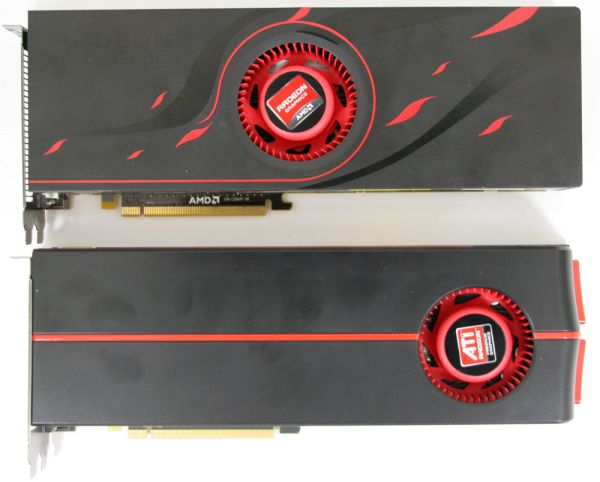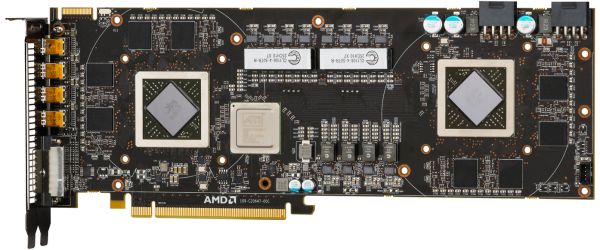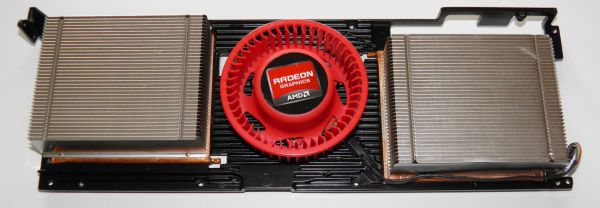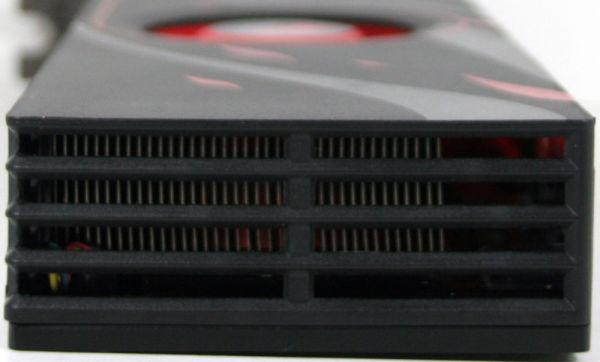AMD's Radeon HD 6990: The New Single Card King
by Ryan Smith on March 8, 2011 12:01 AM EST- Posted in
- AMD
- Radeon HD 6990
- GPUs
Meet The 6990
If you recall our coverage on the 5970, we found a few areas where AMD was lacking. The cooling on the 5970 was sufficient to run the GPUs even at 5870 clocks and voltages, however the cooling on the VRMs was lacking, leading to real world programs trigging the VRM thermal protection mechanism; and while this was within safety guidelines, it’s not a comfortable place to be for long term operation. This ultimately led to us writing off the 5970OC as a 100% reliable product, sticking to recommending the 5970 solely at stock speeds.
The design of the 6990 in turn reads very much like a response to our findings in true engineering fashion. Furthermore for the 6990 AMD not only had to take a look at the 5970’s weaknesses, but also how to handle an even greater power load. The result is that the 6990 is distinctly different from the 5970 before it.
Compared to the 5970, the 6990 is ever so slightly shorter, thanks in large part to the fact than the 6000 series casing is more squared off compared to the 5000 series’ tapered design. As a result it comes in at 11.5” for the PCB (the same as the 5970), and with casing a full 12” long compared to the 5970’s 12.16”. This means that the 6990 has effectively the same space requirements as the 5970, cooling notwithstanding.
Meanwhile it’s the fan however that is going to catch the most attention and this is where we’re going to dovetail in to cooling. The 5970’s traditional blower had its strengths and weaknesses, the strengths being that blowers are relatively forgiving about a case’s ability to exhaust hot air, and the weaknesses being that the GPU (and VRMs) closest to the fan received better cooling than the farther GPU. The VRMs proved to be particularly problematic, as they could overheat well before the GPUs did and AMD does not spin up their fans based on VRM temperatures.
Correcting for this and at the same time allowing for even greater heat dissipation, the rear blower design is out. Its replacement is a design that we’ve seen in 3rd party cards before such as the Asus ARES 5870X2, but not in a reference design: a center-mounted fan/blower with a GPU to each side. The difference is critical and indeed cannot be understated: a rear blower channels most hot air outside of the case, while a center-mounted blower effectively splits the card in two, with one GPU + supporting chips being exhausted outside of the case, and the 2nd GPU + supporting chips being exhausted inside the case. The design is still enclosed, so everything goes out either the front or back of the card while fresh air is pulled in the center.
With the replacement of the blower, so has gone the heatsink. The 5970’s single large vapor chamber + heatsink design has been replaced in favor of a segmented heatsink, further driving home the concept that the 6990 is closer to 2 video cards sharing 1PCB than it is 2 GPUs on one card. Each heatsink in turn is connected to the GPU via its own vapor chamber, resulting in the GPUs being fully isolated from each other as far as cooling is concerned.
Even the thermal paste connecting the GPUs to the vapor chambers has been changed for the 6990 – AMD has replaced traditional paste with a phase change material. Phase change materials – pastes/pads of material that melt and solidify based on temperature are nothing new, however they’re still exotic; material similar to what AMD is using is not readily available as paste is. AMD even went so far as to suggest that reviewers not directly disassemble their 6990s as it would require a new application of phase change paste in order to achieve the same efficiency as the original material. The net result of all of this by AMD’s numbers is that the phase change material is 8% better than the regular paste they’ve been using.
Rounding out our focus on cooling is the VRMs, which have been relocated in order to correct for the 5970’s limited VRM cooling capabilities. The VRMs and controllers are now at the center of the board – now they’re cooled before the GPUs or RAM modules are. The profoundness of this is twofold: not only is it an improvement on the 5970, but with the 6990’s higher power consumption VRM cooling is even more important. As with the 6970, voltage regulation is supplied by Volterra MOSFETs and controllers.
All told, while the 5970 was designed to handle and dissipate 400W of heat, the 6990 is officially designed for 450W. In practice, at its limits in our test rig this is closer to 500W. To handle and dissipate that much heat in roughly 72in3 of space is nothing short of amazing.


















130 Comments
View All Comments
EmmetBrown - Tuesday, March 8, 2011 - link
Nice, but what about the Radeon HD 6450, 6570 and 6670?http://en.wikipedia.org/wiki/Comparison_of_ATI_Gra...
Why they are available for OEM only? They looks interesting, especially the 6670, which with its 480 SP should be faster than the 5670 which has 400 SP and lower frequency. Do you plan to review them?
Ryan Smith - Tuesday, March 8, 2011 - link
As you note, they're OEM only. AMD will release them to the retail market eventually, but clearly they're not in a hurry. It's unlikely we'll review them until then, as OEM cards are difficult to come by.misfit410 - Tuesday, March 8, 2011 - link
I have to ask, if you bring up the price and say that you might as well do two 6950's in SLI when this thing doubles the performance of the GTX580, I mean would it also not be the better solution than a GTX580 which is $500 while two 6950's can apparently double it for $550 being they can be found for $225 after rebates these days.Figaro56 - Tuesday, March 8, 2011 - link
You sound a little confused. You can't run ATI cards in SLI, they run in what is called crossfire (or crossfirex which is the same thing). Two 6950's don't equal GTX580 in SLI. You need two HD 6970 cards in crossfire to nearly equal two GTX580 in SLI.In my opinion, why limit your performance with 2 HD 6950 cards, why not just bye the 2 HD 6970 cards and never have to second guess if you should have or not? But... That's just me. I have a job.
silverblue - Tuesday, March 8, 2011 - link
Totally unnecessary closing comment there, considering most people here do actually have jobs. Not everyone who has a job can afford such gear as there's more important things to spend money on.Thanny - Tuesday, March 8, 2011 - link
You sound confused, too. He miswrote SLI, but you misunderstood his point entirely. He's saying that two 6950's are significantly faster than a single 580 for almost the same price.Loiosh - Tuesday, March 8, 2011 - link
Hey guys, you forgot one other usage case that would necessitate this card: ATI+physx setup: http://www.shackpics.com/viewer.x?file=DumbVideoca...I'm currently running one and it requires a dual-GPU card. :/
In my case I'm waiting for a watercooled version. BTW, you didn't say the release date for this?
nanajuuyon - Wednesday, March 9, 2011 - link
Funny after reading this review I went into town (Tokyo) to buy a new hard disk and saw this card for sale. So in Japan at least it is already on the market..... price was ridiculous though, 79,000YEN or $945 US..... I'm sure it will be available everywhere soon.Waterblocks on the other hand could be a couple month or so away I guess...
Vinas - Tuesday, March 8, 2011 - link
If you buy this you better have it on water. 'nuff said about all this tri slot cooler talk.JPForums - Tuesday, March 8, 2011 - link
First off, nice article Ryan.Good data, relevant commentaries on said data, and conclusions.
You mention in the article that you believe some of the shortcomings of the 6990 to be a lack of PCIe bandwidth. This got me thinking that perhaps it is a good time to revisit the effect of PCIe bandwidth on modern cards. Given the P67 only natively supports 16 lanes, I'm curious to see what effect it has on CF/SLI. It could make big difference in the recommended hardware for various levels of gaming systems.
Typically, someone looking for a CF/SLI setup will get a board that supports more lanes. However, I have seen a situation where a friend built a budget i5 system and about 4 months later was in a position to acquire an HD5970 on the cheap (relatively speaking). Clearly, two HD5850s/HD5870s would have been an option.
If newer cards are effectively PCIe bandwidth limited, then a 6990 may perform more closely to an HD6970 CF setup in such a system than it does in these graphs. This would be even more of a consideration at the high end if the rare boards with support for 4x8 lane (spaced) PCIe give you no real benefit over a more common 2x16 lane board (comparing 4 HD6970s to 2 HD6990s).